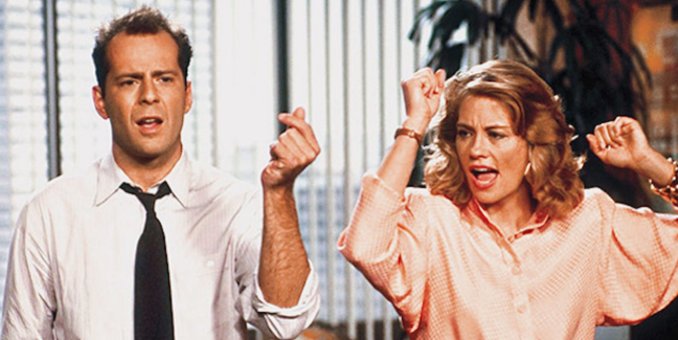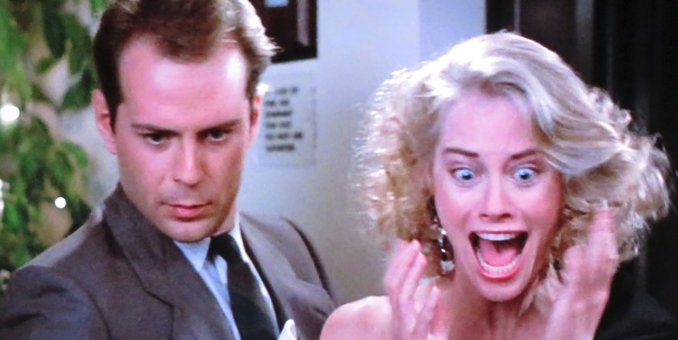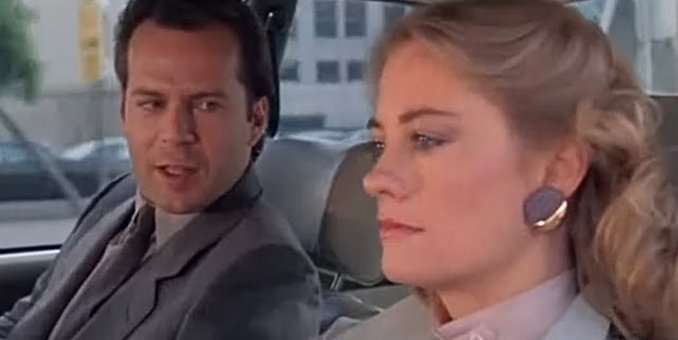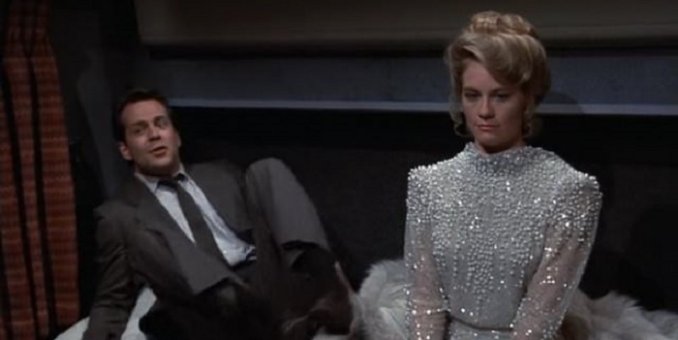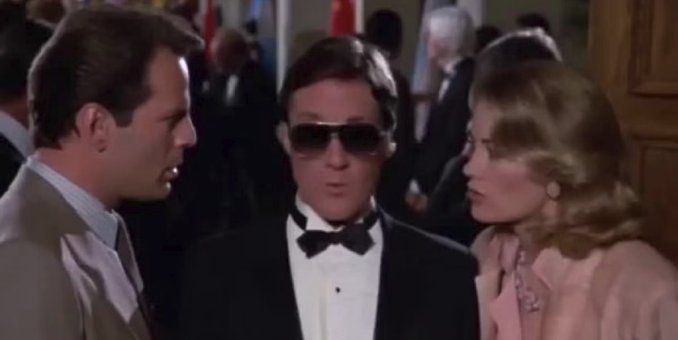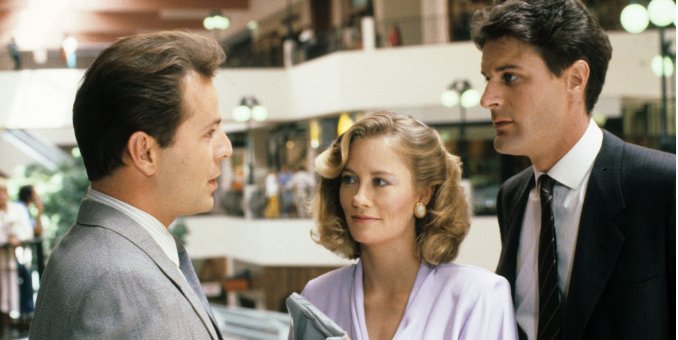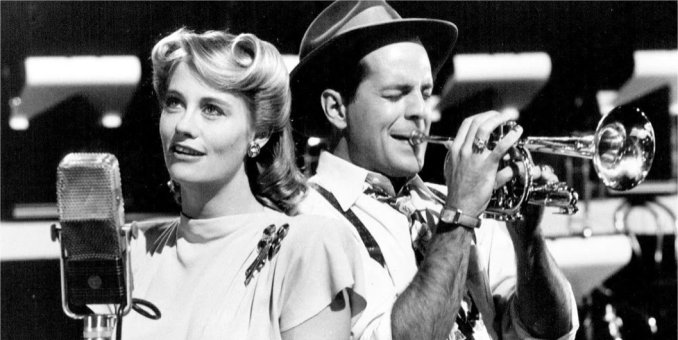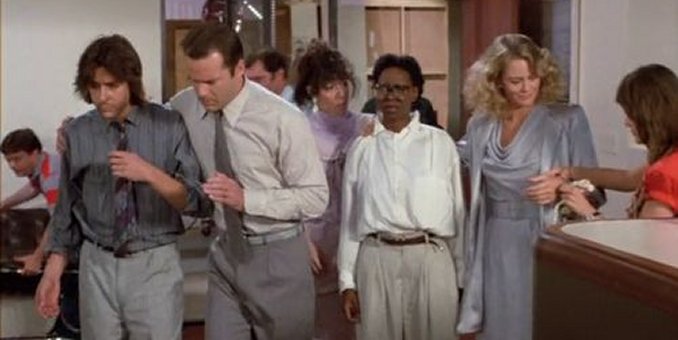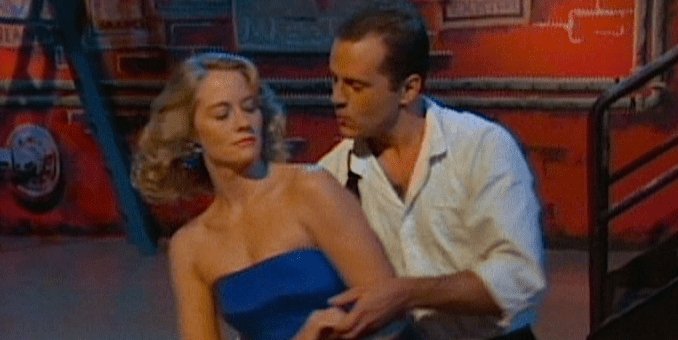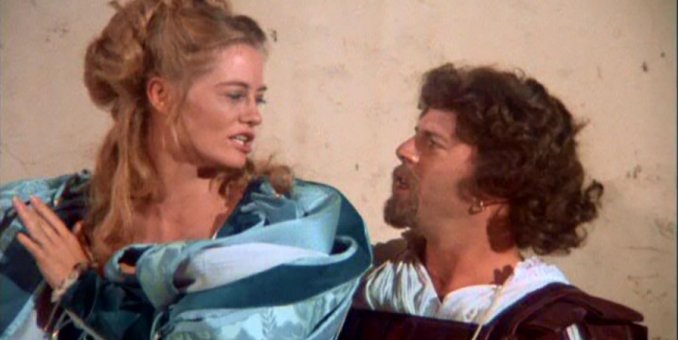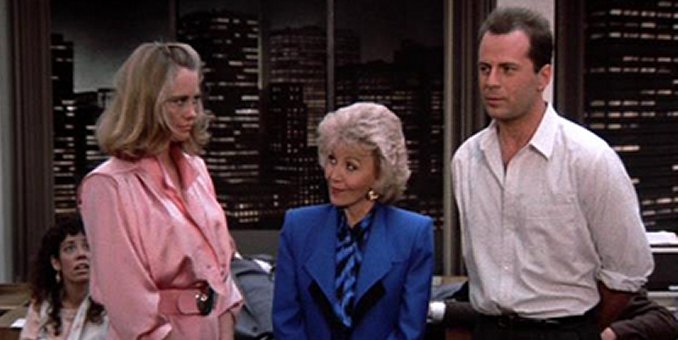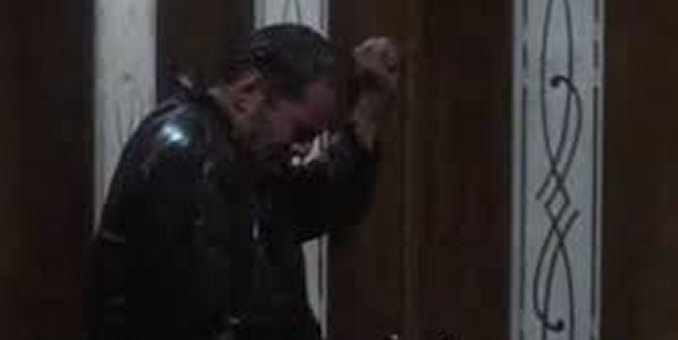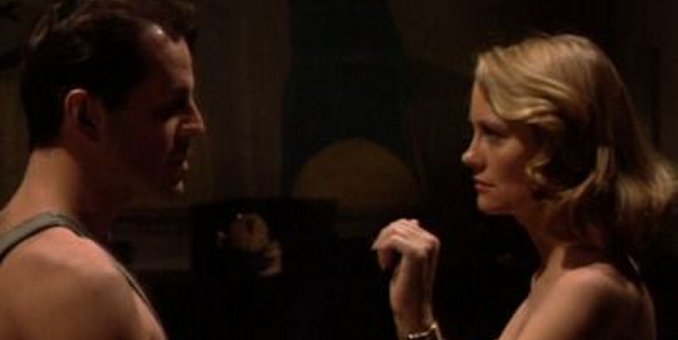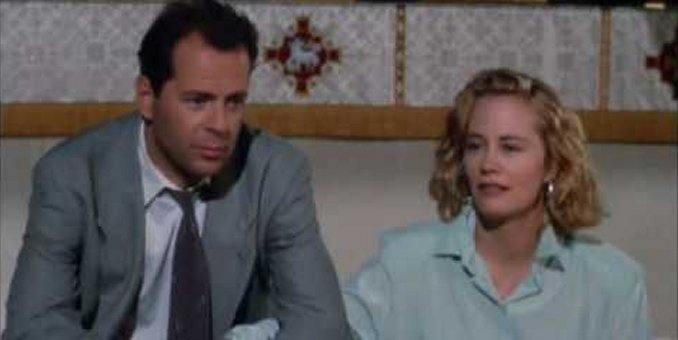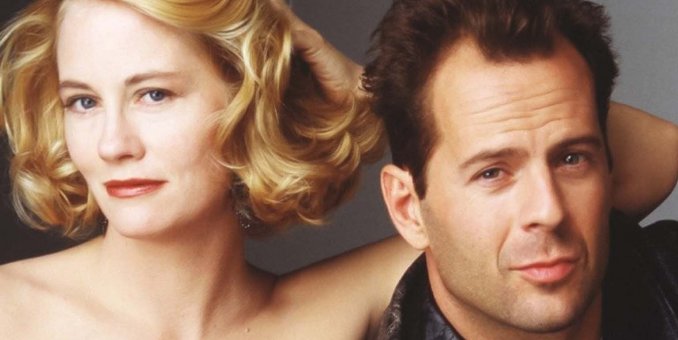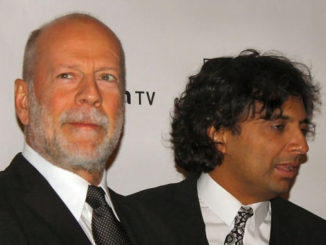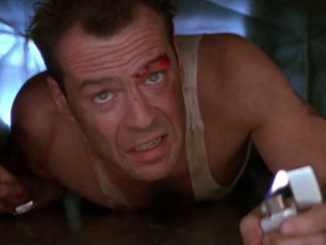One of the biggest television shows of the second half of the 1980s was Moonlighting, a romantic-comedy mystery series featuring real life model-turned-actress Cybill Shepherd and bartender-turned-actor, newcomer Bruce Willis. Almost from the airing of its two hour pilot as an ABC Sunday Night At The Movies special presentation on March 3, 1985, the country was captivated by the back and forth, will they or won’t they banter of its two leads. But the show would become somewhat a victim of its own success as movie stardom beckoned for Willis and his and Shepherd’s off camera funding was as hot as their on screen sparks and the show ended after five seasons.
Unfortunately, the show’s penchant for never completing a full season order for four of its five seasons and a tangled morass of music rights have managed to keep the show out of circulation for the better part of the last two decades. That is until Disney, the company who now owns the series, decided to bring it to streaming, spending the better part of a year working with Caron to untangle the business issues that kept the show from longtime fans and potential new ones as well. Now that it is back on Hulu, here are 13 of the show’s 66 episode run that highlight its growth and high points.
Pilot
Model Maddie Hayes, known as the face of Blue Moon Shampoo, wakes one morning to find her life in financial ruins after her accountant drained her bank accounts and headed to South America. On the advice of her lawyer, she sets out to liquidate the handful of companies that her accountant kept going as tax shelters lest they drain her of any more money. Arriving at one, the City of Angels Investigations, she meets its fast-talking manager, detective David Addison who is strongly opposed to being summarily fired. (And losing access to his company Porche.) While crashing a rather bad dinner she is on, David tries to talk Maddie into changing her mind. But things don’t really change for them when a murder mystery is literally dropped at their feet. The job of any pilot is to set up the show’s premise and introduce its main characters, and the Moonlighting pilot, written by series creator Glenn Gordon Caron, does a masterful job of it. The mystery isn’t the most complex, so it doesn’t get in the way of the sparks the fly almost instantly as Maddie and David get to know each other. By the time the two-hour episode draws to a conclusion, it is hard not to want to stick around to see what cases the newly reopened, and now rechristened, Blue Moon Detective Agency will have come their way.
The Next Murder You Hear (Season 1, Episode 4)
While it would take the show its full first season – which, as a midseason replacement, only consisted of five hour-long episodes – to fully find it groove, there are a number of elements at play here that are starting to jell. David and Maddie have their first classic argument, the one over Maddie’s objection to David’s use of the word “boink.” The mystery that they set out to solve reflects back on their budding relationship, while carrying a bit of a Hitchcockian twist or two. And of course, the pair are in complete disagreement as to who the actual murderer is. The ending may be a little conventional and pat, but the show is getting there.
Next Stop Murder (Season 1, Episode 5)
The first episode to turn the spotlight somewhat onto the Blue Moon Detective Agency’s rhyming secretary Agnes DiPesto, and certainly not the last. Ms. DiPesto wins a contest where the prize is a berth on a private train where her favorite mystery author hosts an annual murder mystery game amongst his friends. Unfortunately, this time around, the murder is real and Ms. DiPesto is the one whom all the clews point to. Fortunately, David and Maddie were accidentally unable to get off the train before it pulled out of the station, so they are able to clear Ms. DiPesto’s name and uncover who the real murderer is. (Though the solution to this one is fairly obvious.)
The Murder Is In The Mail (Season 1, Episode 6)
Moonlighting really starts to hit its stride as the show’s first season comes to an end. This episodes sees David and Maddie turning to some collections work in order to kkep some cash following into agency. Of course, they stumble into a murder plot with some twisty turns that leaves them racing to stop the assassination of a man with a mole on his nose. The episodes culminates with a Doctor Seussian exchange with a CIA agent before having a formal international diplomatic reception degenerate into a food fight.
Brother Can You Spare A Blonde? (Season 2, Episode 1)
Not only does the season 2 opener introduce us to David’s younger brother Richie Addison (Charles Rocket), but it gives us the first instance of one of the series’s most famous tropes – breaking the fourth wall. Rather than the show just opening with the title credits and theme song, the episode opens with David and Maddie in Maddie’s office directly facing the camera, welcoming viewers back for the show’s second season before the fall into a bickering argument about the network. The cold open will return a number of times most notably when David tries to teach Maddie how to be funky with the help of The Temptations and when Burt (Curtis Armstrong, who joined the show late in season 3) tries to sing Sam the Sham and the Pharaoh’s classic “Wooly Bully.”
The Dream Sequence Always Rings Twice (Season 2, Episode 4)
After finding out about a forty-year-old murder where the two suspects – the victim’s wife, a night club singer, and the trumpet player she was having an affair with – both went to the electric chair claiming the other did it, David and Maddie find themselves at odds as to who committed the unsolved crime of passion. The unresolved conflict leads them to dream their own film noir versions of what happened. An introduction from none other than Orson Welles (“Tonight, broadcasting takes a great leap… backwards.”), Cybil Shepard getting to belt out not one, but two showstopping big band numbers and a classic David and Maddie disagreement filtered through The Postman Always Rings Twice and Young Man With A Horn mark this is a one the show’s highlights.
Camille (Season 2, Episode 18)
After conwoman Camille (Whoopi Goldberg) accidentally foils an assassination attempt on a Senator, David is convinced that hiring her would help attract clients. Maddie doesn’t agree, but they pitch her anyways. Despite better offers, Camille takes them up on the job offer, obstensiously as a way to hide from the crooked bunco cop (Judd Nelson) who is on her tail. There is no real murder here and the story focuses more on the characters than the paper-thin plot. But when Judd Nelson catches up them, the chase is on… Right off the set and across the studio’s backlot in one of the biggest fourth wall break the series ever sees.
Big Man On Mulberry Street (Season 3, Episode 6)
David reveals a surprising reason why he suddenly needs to fly to New York City – he was previously married and his former brother-in-law has just passed away. This leads to another of the show’s famous dream sequences, this time with Maddie dreaming about what David’s marriage could have been like. Moonlighting being Moonlighting, the dream takes the form of a 1950’s MGM Technicolor musical production number, complete with dancer Sandahl Bergman and direction from the great Stanley Donen set to the Billy Joel song of the episode’s title. The juxtaposition of the stylized dream musical number and the grounded character moments for both David and Maddie showcase how good the show was at balancing the real drama between its two leads and the flights of fancy it often wanted to take.
Atomic Shakespeare (Season 3, Episode 7)
Possibly the most famous episode of Moonlighting is also one that, on its surface, seems like the least typical episode. There are no murders or mysteries to be solved. But at the same time, it also is emblematic of many of the tropes of the show. The episode’s entire framing device is a fourth wall break as a kid is told by his mother to turn off Moonlighting and go finish his homework – reading Shakespeare’s The Taming Of The Shrew. The rest of the episode is a retelling of the Bard’s classic comedy but with David and Maddie in the roles of bickering couple Petruchio and Katherina It is no surprise that the episode works so well as an ersatz Shakespeare adaption as Moonlighting creator Glenn Gordon Caron has stated that the play was one of the main inspirations for the show.
The Straight Poop (Season 3, Episode 9)
Perhaps the most reflexively meta episode of the series, certainly the most self-depricating, “The Straight Poop” turns the show’s perpetually behind schedule production woes, creator Caron’s last minute script revisions and the tabloid stories about Willis and Shepherd’s on-set friction into the spine of a clip show. Intoning “No new episode again and America wants to know why,” real life entertainment reporter Rona Barrett storms the Moonlighting set to interview David and Maddie and to try and bring a resolution to their problems. The hour serves as a good reminder of all the points that made the series a favorite, and a good thing too, as in just two episodes, the show would finally get to a storyline that fans had been clamoring for, but which would send the show off in a far different direction.
Blonde On Blonder (Season 3, Episode 11)
The first of a four episode story arc – which would air over two months due to, you guessed it, production falling behind schedule – finds David horrified after Maddie announces that she is frustrated with her life and is thinking about finding herself a meaningless one night stand. What follows is the first of a four part storyline that will significantly change the relationship between Maddie and David, the show’s overall tenor and fan’s perception of the series going forward.
I Am Curious… Maddie (Season 3, Episode 14)
The culmination of the Sam and Dave story arc and the payoff to three years of “will they or won’t they?” teasing. David doesn’t react too well to finding out that Sam proposed to Maddie from Sam and not from Maddie. The only mystery to solve this week is what Maddie’s heart really wants, and in the last few minutes it is solved in a most dramatic fashion as she and David tumble into bed while the Shirelles sang “Be My Little Baby” on the soundtrack and 60 million viewers tuned in. But in a classic case of “Be Careful What You Wish For,” the moment may have given fans what they wanted, but it helped set the show down a storytelling direction that at times lost the balance between the romantic comedy and the quirky mysteries. (Though, to be fair, the increasing tension between the stars, their frequent absences from set and other production woes would also incalculably impact season four.)
Lunar Eclipse (Season 5, Episode 13)
With season 5, Moonlighting made a concerted effort to get back to its romantic comedy/mystery original recipe, but it was a bit too late. All but the most loyal fans had fled and on May 14, 1989, the Blue Moon Detective Agency closed its doors forever. Well, actually, the set was dismantled, as witnessed by David and Maddie who are racing to stop the show’s cancellation. Ms. DiPesto and Burt get married (with Timothy O’Leary presiding), but David and Maddie are told by a producer – played by Dennis Dugan who appeared in the show’s fourth season as a man Maddie briefly was married to after meeting on a train* – “Romance is a fragile thing. And when it’s over, it’s over.” And sadly, it was over.
* It was season 4, just go with it.

